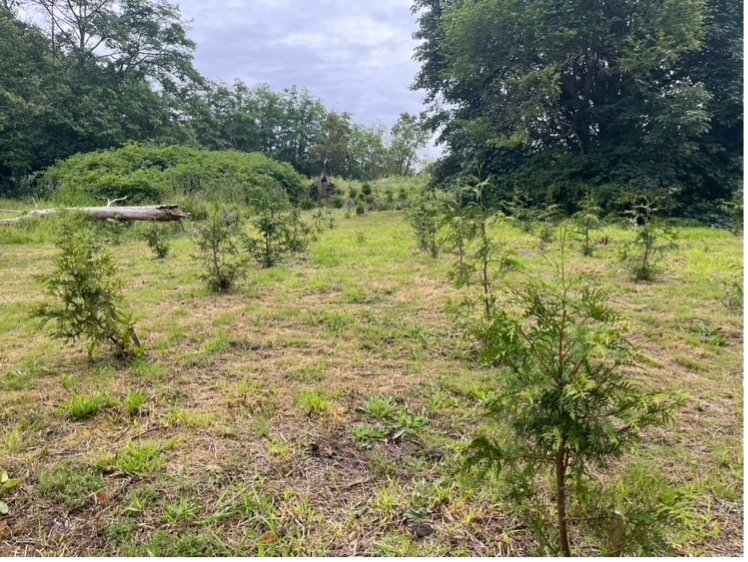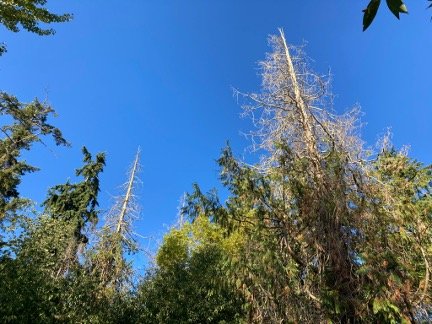Exploring Options for a Future with Western Redcedars.
Written by: Fig Dewitz, Isiah Montejano, Joey Hulbert, WSU Ravenholt Urban Forest Health Lab
Are trees adapted to Oregon climates better suited for future climates in Washington?
This month our team at the WSU Ravenholt Urban Forest Health Lab conducted the annual measurements for the Open Redcedar Adaptation Network. We are now two years into the study, and we are excited to share our findings!
What is the Western Redcedar Adaptation Network?:
In 2022, WSU partnered with Tacoma Tree Foundation, Metro Parks Tacoma, the City of Renton, Seattle Parks and Recreation (Fig. 1, left) to plant Western Redcedar trees from two seed zones (Willamette Valley, OR and Lewis County, WA) at three sites.
Trees were planted at Discovery Park in Seattle, Swan Creek in Tacoma, and Black River Riparian Forest in Renton. The goal of the tree plantings was to establish monitoring sites to determine if Western Redcedar trees from Oregon seed sources would outperform Washington seed source.
Western redcedar trees from each seed zone were grown by Weyerhaeuser.
One-year old plugs were donated to WSU where they were repotted into consistent growing media and grown for an additional year before out-planting.
100 redcedar trees (50 from Washington seed, 50 from Oregon seed) were planted at each site.
All trees were measured at the time of planting, but each site was planted at different times in the Spring of 2022.
Why the Western redcedar?
Western redcedar is a remarkable tree in the Pacific Northwest because of its cultural significance to the First Peoples of the Salish Sea and its prominence in our urban and forested landscapes.
Fig. 2: Culturally modified redcedar.
Unfortunately, Western redcedar dieback has been observed throughout the Northwest, leading to growing concerns about their survival in future climates. Recent Research has linked redcedar mortality to consecutive hotter and drier summers. An additional preliminary study from the WSU Ravenholt Urban Forest Health lab has linked tree health with temperatures, noting higher probabilities of redcedar dieback in hotter areas in Portland, Tacoma, and King County.
Fig. 3: Western redcedar dieback at Wapato Park, Tacoma.
Partnering with Tacoma Tree Foundation at the Western redcedar planting, Swan Creek, Tacoma.
More than 40 volunteers helped plant the redcedar trees at Swan Creek in partnership with the Tacoma Tree Foundation. Thank you to everyone that helped get this project started!
We’re grateful for Tacoma Tree Foundation’s support. This project is a demonstration of their continued impact and positive outcomes for the lands and communities of Tacoma. Thank you TTF!
The Network
The Open Redcedar Adaptation Network was designed to provide opportunities for education and participatory science about climate adaptation. The planting sites are open to anyone interested in visiting, learning more, or even collecting data! Project leaders are especially eager to partner with educators or youth groups to monitor and measure the trees each year.
Fig. 7: Sign Posted at Swan Creek Park Planting Site
The data from this project is maintained openly and it is available at: https://jmhulbert.github.io/adaptation. Educators are also welcome to incorporate the data to their classrooms.
A Possible Solution
Research to explore the potential of assisted seed migration and genetic diversity as a tool for keeping Western redcedar healthy for future generations is needed.
The sites planted as part of this project are small demonstrations of the potential for climate adaptation. Readers can visit each site themselves to compare how trees from Oregon are performing compared to trees from Washington.
Together, we can investigate if redcedar trees adapted to climates in Oregon will be better suited for upcoming climates in Washington.
2024 Results
Western redcedar trees at all three sites were remeasured for the second time in the Spring 2024. Over all three sites, western redcedar trees from Oregon grew slightly faster than the trees from Washington seed zones in both years.
Fig. 8: Growth of western redcedar tree heights (cm) across all three sites for each year and cumulatively.
The same growth patterns were observed when comparing the diameter growth of the trees. More information and plots are available at https://jmhulbert.github.io/adaptation.
Measurements over longer periods are certainly needed. One hypothesis projected that the Western redcedar trees from the Washington seed source would outperform trees from the Oregon seed source initially. But that did not seem to be the case. However, two years is not very long when considering the life of a tree, and it is unclear how the trees from the Oregon seed zone would perform if we had a particularly cold year.
Furthermore, growth is only one metric of performance. Monitoring tree health and survival is also critical to understanding if Western redcedar can be conserved with assisted seed migration. In the 2024 remeasurement, 18 trees from Washington seed zones had died across all three sites—only 8 trees from Oregon seed zones had died. However, tree health assessments indicated more trees from Oregon seed zones were unhealthy than trees from Washington seed zones. Stay tuned or get involved to learn more or help monitor these trees over longer periods.
Get Involved!
Do you want to be involved or engage your students in this project?
These plantings were initially designed for use in classrooms and learning activities about climate adaptation. Educators and students can measure the trees, report tree conditions, compare Washington and Oregon seed sources, analyze data, and share what they find.
Sign up or contact us at: https://foresthealth.org/adaptation to get involved.
You can also help accelerate research about the dieback of Western redcedar by contributing to the Western Redcedar Dieback Map project. These observations are invaluable for understanding the factors affecting the health of Western redcedar. But climate adaptation studies like the above project are needed to explore options for keeping Western redcedar healthy for future generations.
Collaborators
Open Redcedar Adaptation Network is powered by:
· Washington State University
· Seattle Parks and Recreation
· Metro Parks Tacoma
· Tacoma Tree Foundation
· City of Renton
· Manulife Investment Management
· Weyerhaeuser
Learn more or contact us at: https://treehealth.wsu.edu/adaptation/redcedar/







